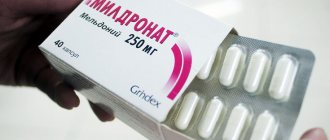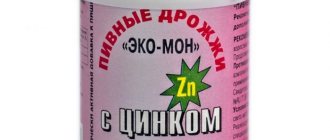Composition and release form
| Pills | 1 table |
| loratadine | 10 mg |
| excipients: milk sugar; MCC; calcium stearate, sodium starch glycolate |
in blister packs 7 or 10 pcs.; in a box 1 package (7 pcs.), 1 or 3 packages (10 pieces).
| Syrup | 1 ml |
| loratadine | 1 mg |
| excipients: sugar; propylene glycol; benzoic acid; citric acid; ethyl alcohol 95%; tropeolin O; food flavorings; purified water |
in bottles of 100 ml; 1 bottle in a cardboard pack.
Loratadine: how much to drink
To prevent overdose and side effects, it is worth knowing for how long you are allowed to take the medicine.
Adults and children over 12 years of age take 1 tablet once a day. If taken in syrup form, the daily dose is 10 mg.
Children from 3 to 12 years old take ½ tablet per day. The daily dose in syrup form is 5 mg.
The average duration of the treatment course is 1-2 weeks, in some cases the treatment can be extended to 30 days. A more precise duration of the treatment course can be determined by your doctor.
Pharmacokinetics
Suction. When taken orally at the recommended therapeutic dose, loratadine is quickly and completely absorbed from the gastrointestinal tract. Determinable concentrations of loratadine appear in the blood plasma within 15 minutes after administration. The time to reach Cmax of loratadine in plasma is 1.3–2.5 hours, and the time to reach Cmax of its active metabolite is 2.5 hours. Simultaneous intake of food and loratadine slows down the achievement of Cmax of loratadine and its active metabolite in plasma by 1 hour, but Cmax of these substances in plasma remains unchanged and no clinical manifestations of interaction of loratadine with food are observed. In elderly people, the time to reach Cmax increases to 1.5 hours, and with alcoholic liver damage it increases with increasing severity of the disease. The content of loratadine and its active metabolite in the blood plasma reaches a steady-state level in most patients on the fifth day of administration. Communication with plasma proteins - 97%.
Metabolism. Loratadine is metabolized in the liver to form the active metabolite descarboethoxyloratadine mainly under the influence of the cytochrome P450 isoenzyme CYP3A4 and to a lesser extent under the influence of the cytochrome P450 isoenzyme CYP2D6. In the presence of ketoconazole, which is a CYP3A4 inhibitor, loratadine is converted to descarboethoxyloratadine primarily by CYP2D6.
Excretion. Loratadine is excreted by the kidneys and bile. The mean half-life of loratadine is 8.4 hours (range, 3 to 20 hours), and for the active metabolite, 28 hours (range, 8.8 to 92 hours). In elderly patients, T1/2 of loratadine increases to 18.2 hours (range from 6.7 to 37 hours), and descarboethoxyloratadine - to 17.5 hours (range from 11 to 38 hours). With alcoholic liver damage, T1/2 increases with increasing severity of the disease. In patients with chronic renal failure and during hemodialysis, the pharmacokinetics remain virtually unchanged.
Pharmacodynamics and pharmacokinetics
Clarotadine is a histamine H1 receptor blocker that exhibits long-term antiallergic, antiexudative and antipruritic effects . The development of the antiallergic effect is observed 30 minutes after administration and persists for at least 24 hours. At the same time, the drug does not affect the nervous system, nor does it have anticholinergic or sedative effects.
The active substance is characterized by good absorption from the gastrointestinal tract. Food does not affect the absorption process, but somewhat slows down the formation of the maximum concentration. Typically, the maximum concentration in plasma is reached after 1.3-2.5 hours. The drug does not penetrate the BBB. The half-life of the component occurs within 24 hours.
Excretion occurs in urine unchanged. At the same time, the patient’s age, liver and kidney disorders do not affect physiological parameters.
Side effects
From the nervous system: anxiety, agitation (in children), asthenia, drowsiness, hyperkinesia, paresthesia, tremor, amnesia, depression.
From the skin and subcutaneous fat: dermatitis.
From the genitourinary and urinary system: change in urine color, painful urge to urinate, dysmenorrhea, menorrhagia, vaginitis.
Metabolic: weight gain, sweating, thirst.
From the musculoskeletal system: cramps of the calf muscles, arthralgia, myalgia.
From the digestive system: changes in taste, anorexia, constipation or diarrhea, dyspepsia, gastritis, flatulence, increased appetite, stomatitis.
From the respiratory system: cough, bronchospasm, dry nasal mucosa, sinusitis.
From the senses: blurred vision, conjunctivitis, pain in the eyes and ears.
From the cardiovascular system: decreased or increased blood pressure, palpitations.
Allergic reactions: angioedema, urticaria, itching, photosensitivity.
Other: back pain, chest pain, fever, chills, breast pain, blepharospasm, dysphonia.
Side effects
When taking Clarotadine, all sorts of side effects can develop, affecting various systems and organs, for example: the functions of the nervous, digestive, respiratory, musculoskeletal, urinary, reproductive, cardiovascular and other systems. Disturbances can manifest themselves as: anxiety, agitation, asthenia , drowsiness , tremor, anorexia, constipation, diarrhea, dyspepsia , cough, sinusitis, arthralgia, myalgia and many other symptoms.
Deviations in metabolism, the functioning of sensory organs, and the development of allergic and dermatological reactions are also possible.
Interaction
When using loratadine in therapeutic doses, no potentiating effect on alcohol was detected.
The combined use of loratadine with erythromycin, cimetidine and ketoconazole increases the concentration of loratadine in the blood plasma, which has no clinical manifestations and does not affect ECG data.
Inducers of microsomal oxidation (phenytoin, ethanol, barbiturates, zixorin, rifampicin, phenylbutazone, tricyclic antidepressants) reduce the effectiveness of the drug.
Loratadine
Suction
Quickly and completely absorbed from the gastrointestinal tract. The time to reach the maximum concentration (Tmax) of loratadine in the blood plasma is 1-1.5 hours, and its active metabolite desloratadine is 1.5-3.7 hours. Food intake increases the Tmax of loratadine and desloratadine by approximately 1 hour, but has no effect on the effectiveness of the drug. The maximum concentration (Cmax) of loratadine and desloratadine does not depend on food intake. Cmax of loratadine increases in elderly patients, patients with chronic renal failure or alcoholic liver damage.
Distribution
The bioavailability of loratadine and its active metabolite is dose-dependent. Loratadine has a high degree (97-99%), and its active metabolite has a moderate degree (73-76%) of binding to plasma proteins. Equilibrium concentrations of loratadine and metabolite in the blood plasma are achieved on the fifth day of administration. Does not penetrate the blood-brain barrier.
Metabolism
Metabolized in the liver to form the active metabolite desloratadine (descarboethoxyloratadine) with the participation of the cytochrome P450 isoenzyme CYP3A4 and, to a lesser extent, the cytochrome P450 isoenzyme CYP2D6.
Removal
Excreted through the kidneys (approximately 40% of the oral dose) and intestines (approximately 42% of the oral dose) for more than 10 days, mainly in the form of conjugated metabolites. Approximately 27% of an oral dose is excreted through the kidneys within 24 hours after taking the drug. Less than 1% of the active substance is excreted unchanged through the kidneys within 24 hours after taking the drug. The half-life (T1/2) of loratadine ranges from 3 to 20 hours (average 8.4 hours), and that of desloratadine ranges from 8.8 to 92 hours (average 28 hours).
Pharmacokinetics in special groups of patients
Elderly age
The pharmacokinetic profiles of loratadine and its active metabolite were comparable in adults and elderly healthy volunteers.
T1/2 of loratadine in elderly patients ranges from 6.7 to 37 hours (average 18.2 hours), and desloratadine - from 11 to 39 hours (average 17.5 hours).
Patients with liver dysfunction
In patients with alcoholic liver damage, the Cmax and area under the concentration-time curve (AUC) of loratadine and its active metabolite increase by one-fold compared to these indicators in patients with normal liver function. At the same time, T1/2 of loratadine and T1/2 of its active metabolite increase with increasing severity of the disease.
Patients with impaired renal function
In patients with chronic kidney disease, the Cmax and AUC of loratadine and its active metabolite are increased compared to these values in patients with normal renal function. At the same time, T1/2 of loratadine and T1/2 of its active metabolite do not differ from those in healthy patients.
Hemodialysis in patients with chronic renal failure does not affect the pharmacokinetics of loratadine and its active metabolite.
Overdose
When taking loratadine in doses significantly higher than the recommended therapeutic dose of 10 mg (40–180 mg loratadine), adult patients may experience symptoms such as headache, drowsiness, and tachycardia. When loratadine is used in children weighing less than 30 kg at a dose of more than 10 mg, extrapyramidal symptoms and increased heart rate may be observed.
Treatment: you should consult a doctor, take measures to remove the drug from the gastrointestinal tract and reduce absorption (induction of vomiting, gastric lavage, taking activated charcoal). If necessary, symptomatic therapy is carried out. Loratadine is not excreted from the body during hemodialysis. There are no data on the elimination of loratadine during peritoneal dialysis.
Similar drugs:
- Dexamethasone Solution for intravenous and intramuscular administration
- Calcium gluconate Chewable tablets
- Pulmicort Suspension for inhalation
- Cetrine Oral tablets
- Sodium cromoglicate Substance-powder
- Diprospan Solution for injection
- Mometasone furoate Substance-powder
- L-cet Oral tablets
- Dexamethasone Solution for injection
- Adrenaline (Adrenaline) Solution for injection
** The Drug Directory is intended for informational purposes only. For more complete information, please refer to the manufacturer's instructions. Do not self-medicate; Before starting to use the drug Clarotadine, you should consult a doctor. EUROLAB is not responsible for the consequences caused by the use of information posted on the portal. Any information on the site does not replace medical advice and cannot serve as a guarantee of the positive effect of the drug.
Are you interested in the drug Clarotadine? Do you want to know more detailed information or do you need a doctor's examination? Or do you need an inspection? You can make an appointment with a doctor - the Euro lab is always at your service! The best doctors will examine you, advise you, provide the necessary assistance and make a diagnosis. You can also call a doctor at home . Euro lab clinic is open for you around the clock.
** Attention! The information presented in this medication guide is intended for medical professionals and should not be used as a basis for self-medication. The description of the drug Clarotadine is provided for informational purposes and is not intended for prescribing treatment without the participation of a doctor. Patients need to consult a specialist!
If you are interested in any other drugs and medications, their descriptions and instructions for use, information about the composition and form of release, indications for use and side effects, methods of use, prices and reviews of drugs, or you have any other questions and suggestions - write to us, we will definitely try to help you.
Contraindications and side effects
You should avoid taking Loratadine in the following cases:
- individual intolerance to the constituent components;
- breastfeeding period;
- 1st trimester of pregnancy;
- age up to 2 years.
If the child weighs less than 30 kg, then it is best to give him the drug in syrup form.
People with serious liver diseases and patients with diabetes mellitus should take it with caution.
If you do not follow the instructions, neglect contraindications and permissible doses, the following adverse reactions may occur:
- headache;
- weakness, lethargy, drowsiness;
- dizziness;
- tachycardia;
- feeling of dry mouth;
- alopecia;
- increased appetite;
- changes in kidney function.
Children from 2 to 12 years old may experience adverse reactions in the form of irritability, drowsiness and headache.
There may be cases of overdose, which is manifested by the side effects described above. In this case, you need to rinse the stomach, drink enterosorbent and take care of symptomatic treatment.





